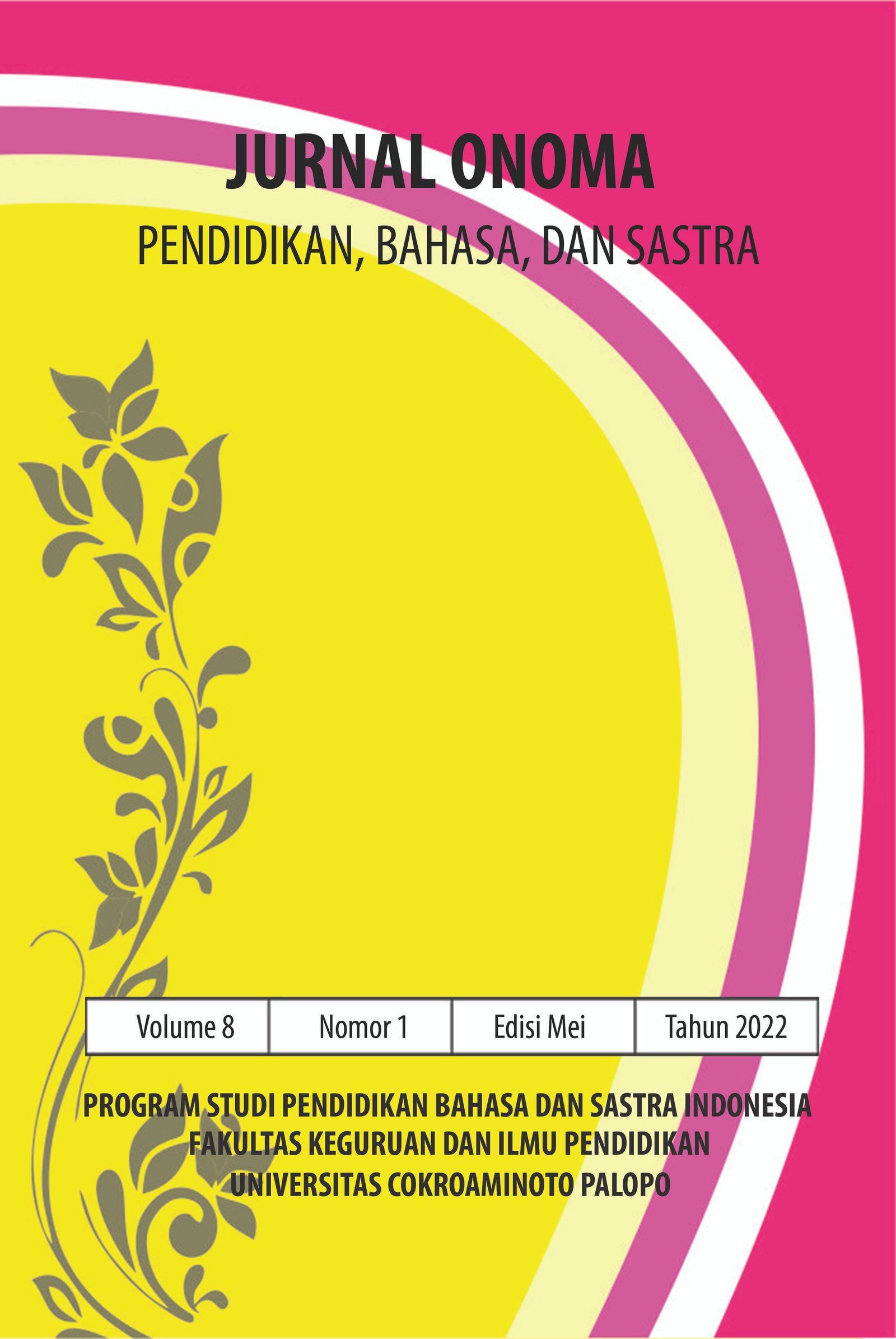A Review Of The Act Of Category-Shifts In Giving An Equivalence In French-Indonesian Novel Translation “Orang Asing” By Albert Camus
English
https://doi.org/10.30605/onoma.v8i1.1728
Keywords:
Category-Shifts In Giving An Equivalence In French-Indonesian Novel TranslationAbstract
Translation is an action of transferring message from source language (SL) to target language (TL) by using the translation technique. The equivalence is a key that will help the reader in understanding the author’s information. In other words, the activity of translating must obey the technique and strategy in order to transmitting the real meaning of each sentences. This study aimed to reveal and describe the category-shifts and its purpose in Indonesian translation text of the novel “orang asing” by Albert Camus that has been translated from the French version “étranger”in giving an equivalence to the target language (TL). The focus of this study is to identify the type of category-shifts such as “structure-shifts, unit-shifts, class-shifts and intra-system-shifts” using the theory of Catford (1978). The methods using in this study is a qualitative design by Kothari (2004) which intend to do a literature study and observation in the data source. The result of the analysis shows that there are many shifting appear from the source language (SL) to the target language (TL). The first aspect provoke this shifting is the culture of the translators and the second aspect is influenced by the translator’s language style.
Downloads
References
Ariefyanti, N., & Gunawan, W. (2018). Structural Shifts in the English-Indonesian Novel Translation: A Systemic Functional Linguistics Analysis. Passages, 6, 86–107.
Baker, M. (2018). In other words: A coursebook on translation (Third edition). Routledge, Taylor & Francis Group.
Camus, A. (1971). L’Étranger. Gallimard.
Camus, A., & Djokosujatno, A. (2013). Orang asing.
Catford, J. C. (1978). A linguistic theory of translation: An essay in applied linguistics (5th impr). Oxford Univ. Press.
Englund Dimitrova, B., Alvstad, C., Hild, A., & Tiselius, E. (Eds.). (2011). Methods and strategies of process research: Integrative approaches in translation studies. John Benjamins Pub. Co.
Fawcett, P. D. (2003). Translation and language: Linguistic theories explained. St. Jerome Pub.
Fouad, A., & Sadkhan, R. (2019). Translation Lexical Shifts in The Swing with Reference to Culture-Specific Items.
Guidère, M. (2008). Introduction à la traductologie: Penser la traduction: hier, aujourd’hui, demain. De Boeck.
Hartono, R. (2017). Pengantar Ilmu Menerjemah (Teori dan Praktek Penerjemahan). Cipta Prima Nusantara.
Jakindo, E., Mayuni, I., & Rasyid, Y. (2018). Loan-Address Terms to Enhance Atmosphere of Source Novel in Target Novel. Humaniora, 9(3), 305–320. https://doi.org/10.21512/humaniora.v9i3.4811
Kothari, C. R. (2004). Research Methodology: Methods and Techniques. New Age International Pvt. Ltd., Publishers.
Newmark, P. (1988). A textbook of translation. Prentice-Hall International.
Romdhati, A. T., Nababan, M., & Santosa, R. (2018). Translation Techniques and Their Impacts to the Modality Orientation’s Shift in The Jungle Book Movie Subtitle. Lingua Cultura, 12(4), 375. https://doi.org/10.21512/lc.v12i4.4397
Sajarwa. (2017). Deconstructing Equivalence in the Translation of Texts from French to Indonesian. Humaniora, 29, 159–168.
Sipayung, K. T. (2018). The Impact of Translation Shift and Method on Translation Accuracy Found at Bilingual History Textbook. Jurnal Humaniora, 30(1), 58. https://doi.org/10.22146/jh.27754
Suparman, S. (2019). Transkripsi Fonetis Cerita Rakyat Massenrempulu. Jurnal Onoma: Pendidikan, Bahasa, Dan Sastra, 5(1), 314-327.
Sipayung, K. T. (2020). The Impact of Translation Method and Shift on Translation Quality at Bilingual Textbooks of Physics, Mathematics and History. Lingua Cultura, 14(1), 79–85. https://doi.org/10.21512/lc.v14i1.6387
Suparman, S., & Charmilasari, C. (2017). Analysis of Phase Structure Realization in Classroom Discourse: A Study of Systemic Functional Linguistics. Ethical Lingua: Journal of Language Teaching and Literature, 4(2), 120-126.
Taufiqi, M. A., Hartono, R., & Mujiyanto, J. (n.d.). The The Influence of Class Shift on Achieving Semantic Meaning in the English-Indonesian Translation of Yule’s Pragmatics | English Education Journal. Retrieved November 30, 2021, from https://journal.unnes.ac.id/sju/index.php/eej/article/view/29395
Downloads
Published
How to Cite
License
In submitting the manuscript to the journal, the authors certify that:
- They are authorized by their co-authors to enter into these arrangements.
- The work described has not been formally published before, except in the form of an abstract or as part of a published lecture, review, thesis, or overlay journal.
- That it is not under consideration for publication elsewhere,
- That its publication has been approved by all the author(s) and by the responsible authorities – tacitly or explicitly – of the institutes where the work has been carried out.
- They secure the right to reproduce any material that has already been published or copyrighted elsewhere.
- They agree to the following license and copyright agreement.
License and Copyright Agreement
Authors who publish with Onoma Journal: Education, Languages??, and Literature agree to the following terms:
- Authors retain copyright and grant the journal right of first publication with the work simultaneously licensed under Creative Commons Attribution License (CC BY 4.0) that allows others to share the work with an acknowledgment of the work's authorship and initial publication in this journal.
- Authors are able to enter into separate, additional contractual arrangements for the non-exclusive distribution of the journal's published version of the work (e.g., post it to an institutional repository or publish it in a book), with an acknowledgment of its initial publication in this journal.
- Authors are permitted and encouraged to post their work online (e.g., in institutional repositories or on their website) prior to and during the submission process, as it can lead to productive exchanges, as well as earlier and greater citation of published work.

















